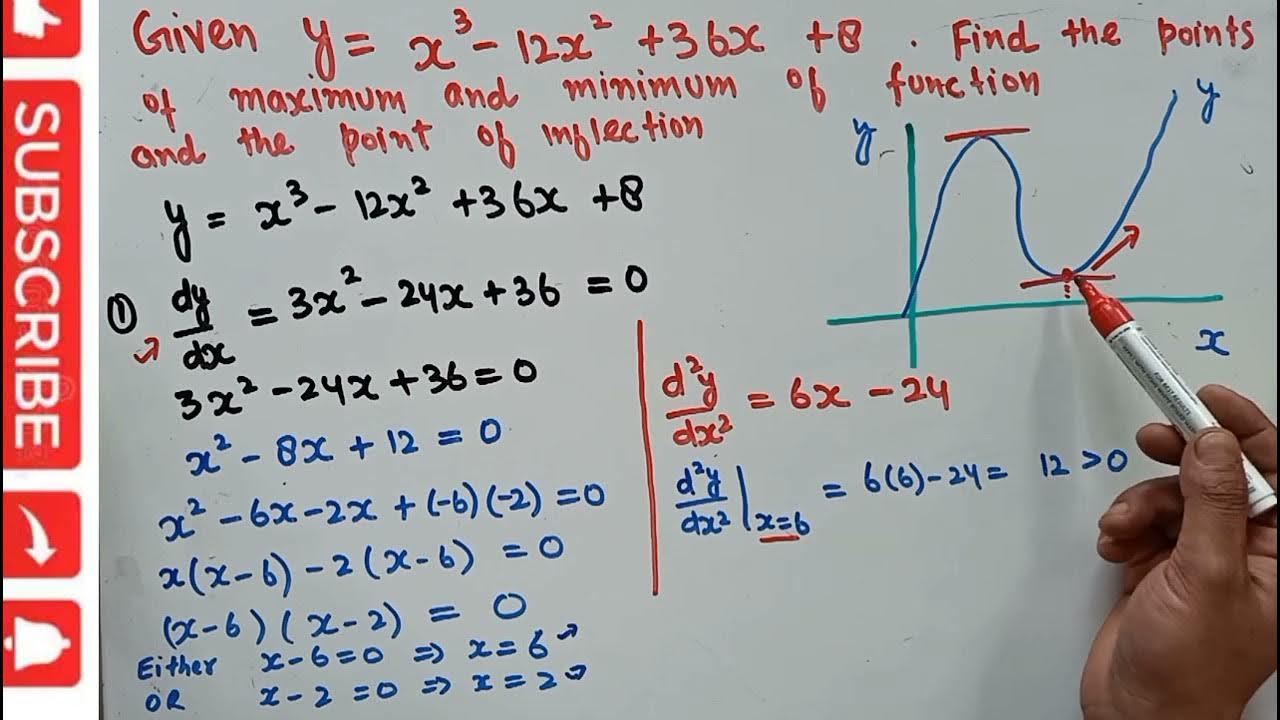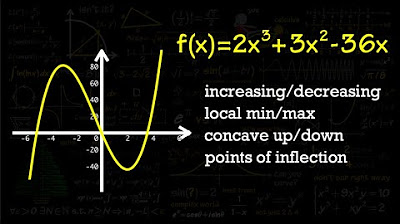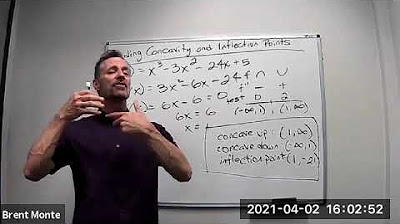Fiding Relative Max, Min and Inflection Point with Derivatives F4
TLDRThe video script demonstrates the process of using derivatives to identify maximum and minimum points, as well as inflection points, of a given function. The function in question is (3x^2 + 6x - 9), and the derivative is taken to find critical points at (x = -3) and (x = 1). The second derivative test is applied to determine that (x = -3) is a relative maximum and (x = 1) is a relative minimum. An inflection point is found at (x = -1). The script then uses a calculator to find the exact coordinates of these points, which are (-3, 12) for the maximum, (1, -20) for the minimum, and (-1, -4) for the inflection point. The graphical representation confirms these findings, showing the function's behavior and the location of the critical points and inflection point.
Takeaways
- 🔍 We will use derivatives to find all maximums, minimums, and inflection points for the given function.
- 📝 The first step is to take the derivative of the function, resulting in 3x² + 6x - 9.
- ➗ Setting the derivative to zero, we factor to find critical points at x = -3 and x = 1.
- 🔬 Using the second derivative test, we find the second derivative to be 6x + 6.
- 🧪 Setting the second derivative to zero, we identify a potential inflection point at x = -1.
- 📉 Evaluating the second derivative at x = -3, we get a negative value, indicating a relative maximum at x = -3.
- 📈 Evaluating the second derivative at x = 1, we get a positive value, indicating a relative minimum at x = 1.
- 🔄 Confirming the inflection point at x = -1 using the number line method, we find a concave down to concave up transition.
- 📊 Using a calculator to find function values, we determine the relative maximum at (-3, 12), the relative minimum at (1, -20), and the inflection point at (-1, -4).
- 🖥️ Graphing the function, we visually confirm the relative maximum, minimum, and the inflection point as calculated.
Q & A
What is the main purpose of the problem discussed in the script?
-The main purpose is to use derivatives to find all the local maxima, minima, and inflection points for a given function and then verify these findings graphically.
What is the given function in the script?
-The script does not explicitly provide the original function, but it mentions that its derivative is 3x^2 + 6x - 9.
How does the script suggest finding critical points?
-The script suggests finding critical points by taking the derivative of the function, setting it to zero, and solving for x.
What are the critical points found in the script?
-The critical points found are x = -3 and x = 1.
What is the method used to determine whether a critical point is a maximum, minimum, or neither?
-The second derivative test is used to determine the nature of the critical points. If the second derivative is positive at a point, it is a minimum; if negative, it is a maximum.
What is the second derivative of the function?
-The second derivative of the function is 6x + 6.
How does the script find the inflection point?
-The script sets the second derivative equal to zero to find the inflection point, which occurs at x = -1.
What are the coordinates of the local maximum and minimum found in the script?
-The local maximum is at the point (-3, 12), and the local minimum is at the point (1, -20).
How does the script verify the findings graphically?
-The script suggests adjusting the window of the graph to view the relative maximum, minimum, and inflection point, ensuring they match the analytical findings.
What is the y-coordinate of the inflection point found in the script?
-The y-coordinate of the inflection point is -4.
What does the script suggest as a method to quickly find a few values for the function?
-The script suggests using a calculator with a table function to quickly find values for the function at specific x-values.
Outlines
📚 Derivative Analysis for Function Maxima and Inflection Points
This paragraph discusses the process of using derivatives to identify maxima, minima, and inflection points of a given function. The function in question is differentiated to obtain (3x^2 + 6x - 9), which is factored into (x + 3)(x - 1), revealing critical points at x = -3 and x = 1. The second derivative test is utilized to determine the nature of these points, resulting in a relative maximum at x = -3 and a relative minimum at x = 1. Additionally, the second derivative (6x + 6) is set to zero to find the inflection point at x = -1. The paragraph concludes with the calculation of the function's values at these critical points, yielding the relative maximum at (-3, 12), the relative minimum at (1, -20), and the inflection point at (-1, -4).
📈 Graphical Confirmation of Function Characteristics
The second paragraph focuses on graphically confirming the findings from the derivative analysis. It mentions the difficulty of pinpointing the exact location of the inflection point on the graph but estimates it to be around x = -1 with a y-value of approximately -4. The paragraph also describes the relative maximum and minimum points graphically, with the relative maximum at x = -3 reaching a y-value of 12, and the relative minimum at x = 1 with a y-value of -20. The discussion includes setting the appropriate window for the graph to clearly visualize these points, suggesting a y-axis range from at least -20 to 12 for clarity.
Mindmap
Keywords
💡Derivatives
💡Maxima and Minima
💡Inflection Points
💡Critical Points
💡Second Derivative Test
💡Factoring
💡Concavity
💡Graphical Representation
💡Calculator
💡Table of Values
Highlights
Introduction of the problem to use derivatives to find max/min and inflection points.
Derivative of the given function is calculated to be 3x^2 + 6x - 9.
Factoring the derivative to find critical points at x = -3 and x = 1.
Introduction of the second derivative test to determine max/min points.
Second derivative is calculated as 6x + 6.
Setting the second derivative to find potential inflection point at x = -1.
Evaluating the second derivative at x = -3 to confirm a relative maximum.
Verification of a relative minimum at x = 1 using the second derivative.
Explanation of the concavity test using the second derivative.
Identification of an inflection point at x = -1.
Use of a calculator to find the exact points for max/min and inflection.
Graphical representation of the function to confirm the analytical findings.
Setting the graph window to visualize the relative max/min and inflection points.
Graphical confirmation of a relative maximum at x = -3 with a value of 12.
Graphical identification of the inflection point at x = -1 with a value of -4.
Graphical confirmation of a relative minimum at x = 1 with a value of -20.
Transcripts
Browse More Related Video

Maxima , minima and point of inflection

Increasing/Decreasing, Concave Up/Down, Inflection Points

Relative Maxima/Minima Examples

Finding Concavity and Inflection Points

Calculus I: Finding Intervals of Concavity and Inflection point

Absolute Maximum and Minimum Values - Finding absolute MAX & MIN of Functions - Calculus
5.0 / 5 (0 votes)
Thanks for rating: